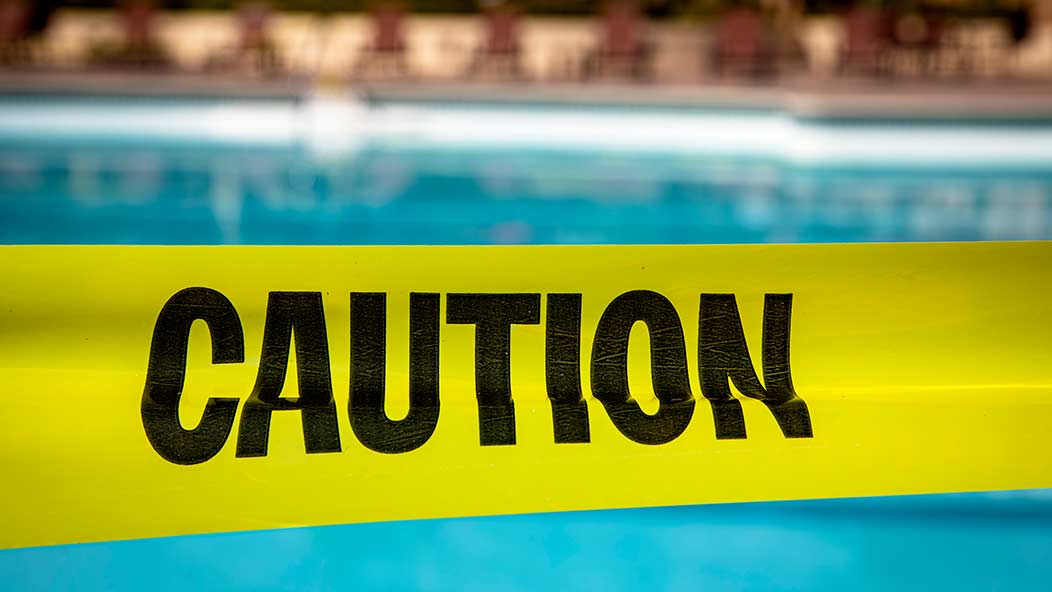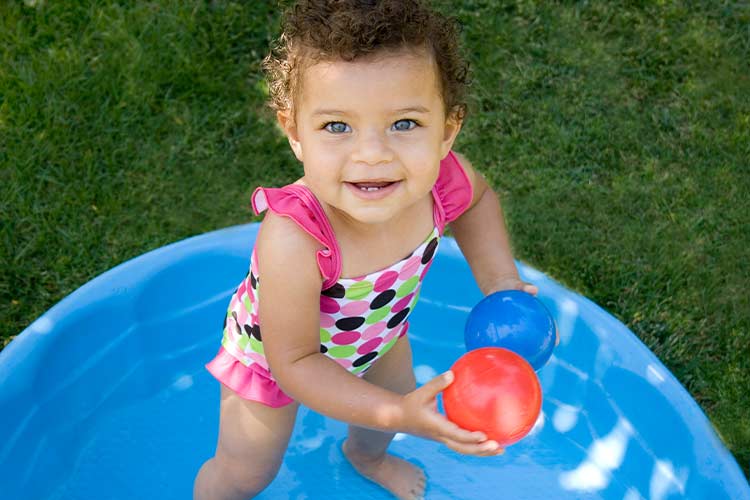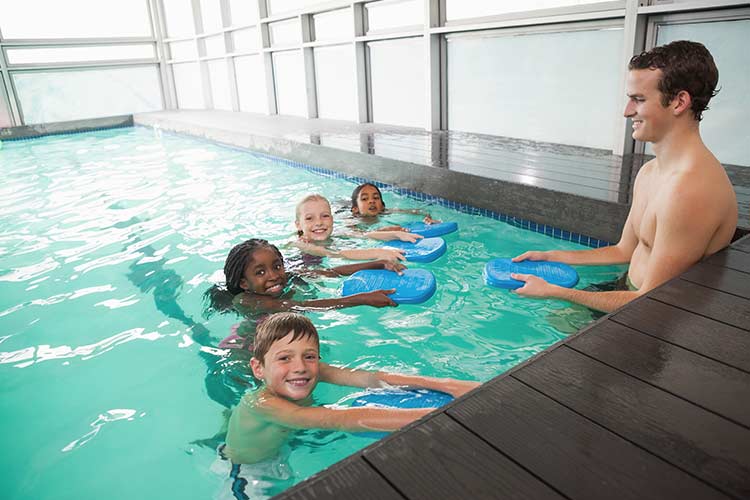Join Our eNewsletter!
Subscribe to our monthly newsletter to receive encouraging advice to help you lead a healthy lifestyle.

Keep Kids Safe Around Water
Summer means the kids are excited to spend time in the water – at the pool, the beach, and water parks – which is a breath of fresh air to parents who’ve spent all school year trying to get their children to go outside. Unfortunately, whenever kids are around water, there’s the possibility of drowning.
According to the Centers for Disease Control and Prevention (CDC), in the United States:
- Drowning is the leading cause of death for children aged 1 to 4 and the second leading cause of unintentional injury for children aged 5 to 14.
- Every year, there are an estimated 4,000 fatal accidental drownings and 8,000 nonfatal drownings.
- Nearly 80% of people who die by drowning are male.
- Black children 10 to 14 years old drown in swimming pools at a rate 7.6 times higher than white children.
- American Indian and Alaska Native people have the highest drowning death rates in natural bodies of water.
Remember, drowning can happen in seconds without warning and is often completely silent. So, with these staggering statistics in mind, before you grab the pool toys and beach towels, take some time to learn how to keep your little ones safe around water.

Common Reasons for Childhood Drownings
There are certain factors and situations that contribute to a child’s chances of drowning. Here are some of the most common ones:
Lack of adult supervision. According to the World Health Organization (WHO), lack of adult supervision is the main contributing factor when children die from drowning. This can include a parent or lifeguard being present but not paying attention while kids are in or near water. This doesn’t just apply to large pools and bodies of water. Kids have drowned in hot tubs, bathtubs, baby pools, and even buckets of water.
Be sure an adult is ALWAYS supervising. Every second a child is around water, a designated adult – never another child – needs to be close enough to touch the child and must pay attention to them without distraction. No phones, no magazines, no visiting with the neighbor for a minute, and definitely no drinking alcohol. If the adult needs to look away, they should hand the supervision duties off to another adult. A tragedy can happen in the time it takes to dig around a tote bag for sunscreen. Even if a lifeguard is on duty, an adult water watcher should still supervise the kids they’re responsible for.

Ineffective or missing safety measures. Most young children who drown in home pools access the pool when no one is watching. They’re able to gain access because there aren’t any safety measures in place, such as a fence or locked gate.
A fence with a self-closing, locking gate should surround any pool or hot tub. The fence should be at least 4 feet high with slats less than 4 inches apart, and it should not be a chain link fence. A pool alarm, which alerts when someone enters the pool, or a door alarm that chimes when the door leading to the pool is opened, can add extra protection.
Relying on floaties. Inflatable flotation devices can give both children and caregivers a false sense of security. Many times, an adult feels they can take their eyes off of a child who’s using floaties because they’re wearing “protection” devices. But a child can easily remove them, or the floaties can slide off or be punctured and deflate. Floaties are not recommended by any organization as a safe personal flotation device because children can still drown when using them.
Instead of floaties, consider having a U.S. Coast Guard-approved life jacket on hand for activities that warrant its use, such as boating or playing at a water park. But never rely on a life jacket to completely protect your child from drowning.
Not knowing how to swim. This applies to both children and adults because, as a USA Swimming Foundation study found, if a parent doesn’t know how to swim, it’s highly likely that their children won’t know how, either. The same study found that up to 60% of children in the U.S. don’t know how to swim.
The Best Defense Against Drowning
Without question, the most effective way to protect your child from drowning is to make sure they – and you – know how to swim. Although this is not a substitute for adult supervision, it does offer an extra and important layer of protection. According to the American Academy of Pediatrics, children can benefit from professional swim lessons as young as 1 year old.
Parents can even opt to take children as young as 6 months old to specialized infant swim lessons that focus on getting babies acclimated to water and teaching them to instinctively float. Since one of the largest factors in drownings is panic, these lessons serve to teach babies and toddlers how to remain calm and swim to safety if they find themselves in trouble in the water.

Whatever age your child begins lessons, they should be learning more than just swim stroke techniques. Make sure the lessons also include water survival skills. Also be sure the instructors are certified through a nationally recognized learn-to-swim curriculum.
If you’re concerned about not being able to afford lessons, check with your local government and community organizations to see if any scholarship programs or payment plans are available.
Lake, River, and Pond Safety
While the same basic principles of water safety also apply to lake, river, and pond safety, there are some additional guidelines to keep in mind when kids are swimming in natural bodies of water.
- Try to find an area with lifeguards on duty, but no matter what, make sure you or another adult is always supervising your children.
- Teach kids to stay away from weeds and grass in or near the water that could entangle a leg or arm.
- Make sure kids follow safety signs, such as not swimming where there could be dangerous wildlife.
- Have kids wear foot protection, such as aqua socks or water shoes, to protect them from jagged rocks, broken glass, and other sharp objects.
- Make sure everyone gets out of the water in bad weather, especially if there’s lightning.
- If you live or stay near a lake, river, or pond, keep all doors locked and install childproofing to ensure children can’t open the doors on their own. Children shouldn’t play outside alone unless they’re in a fenced area with a locked gate.
Beach Safety
In addition to general water safety, swimming on the beach carries its own set of safety guidelines to help protect children from drowning.
- Always get in the water with your child or make sure an adult who knows how to swim is in the water with them.
- Follow posted signs regarding weather, rip currents, jellyfish warnings, surfing restrictions, and other hazards.
- Teach kids to face the water so they can see if a big wave is coming. Also teach them that if they’re pulled under or away from the shore, they should yell for help and try to swim along the shore until they no longer feel pulled.
- Don’t let your kids swim close to piers or other water structures where sudden water movements may push swimmers into them.
- Make sure everyone gets out of the water in bad weather, especially if there’s lightning.
Water Park Safety
Water parks are a lot of fun but require special precautions to help prevent drowning.
- Don’t rely on park employees and lifeguards to supervise your kids. Keep your kids in view at all times, even when they’re on rides.
- Read the posted signs before letting kids go on a ride. Many have age, height, weight, or health requirements.
- Consider which rides are safe for your child's age and development. For example, keep little kids away from older kids who may be playing more aggressively.
- Teach kids to follow the rules and directions, such as walking instead of running and going down water slides in the correct position.
- Some water parks require life jackets for kids under 48 inches tall, so be sure to come equipped with a Coast Guard-approved life jacket that properly fits your child.
The bad news is that drowning can happen to any child. The good news is that it’s highly preventable if adult caregivers take appropriate precautions.








